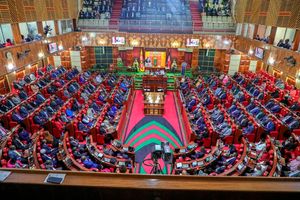
Samburu
Premium
Drought brings death, starvation to Samburu
The stench of rotting human remains made it easier to find the hut in the dry, rocky Kaliwalan village in northern Samburu. The bodies of Angoomo Lokwaliwa, 35, and her five-year-old child lay on their sides in the sand.
Around them, the sand had been marked by small arcs - signs that the two had thrashed about as they struggled to stand up.
There was nothing to eat or drink. Nothing. Not a single drop of water to save Ms Lokwaliwa and her child. The mother was with a group of people traversing the rocky, hilly terrain to Baragoi in search of food and water.

Weakened by hunger, she could not proceed any further with her emaciated child. They had gone days without food or water.
As for Samwel Silale, a village administrator, it was a heartbreaking sight.
“In all my years on earth, I’ve never seen anything as bad as this,” Mr Silale told Nation.Africa.
“She was with a group of people going to Baragoi but she was left behind. Because she was weak, she could not move any further or scream for help. The two succumbed, unfortunately. We are in a crisis,” he says.
Mr Silale says the past few months have been cruel as a drought bites in the region, with mothers and young children forced to walk over 80km in search of wild foods, fruits and water.
Ms Lokwaliwa’s story is similar to those of hundreds of pastoralists in Samburu North. The semi-arid region is on the edge of a catastrophic famine exacerbated by droughts, insecurity and the effects of a locust invasion.

In a dusty deserted area of Parikati, Antonella Arunye and her grandchildren often go to sleep hungry. The effects of malnutrition have been most dramatic on her six-year-old grandchild Aliso Ekiru, whose small, frail body looks much younger than his age.
Cheeks sunken, the 54-year-old stands next to her manyatta speaking about the painful task of telling her grandchildren that “there is nothing to eat again”.
“We usually depend on goat milk to drink but animals are emaciated. Some are dead. Where do we go then?” she says.
“We have not received any aid. I do not need anything more than food for my children, who are starving to death.”

Many residents of this sparsely populated area in the northwest, near the boundary of Samburu and Turkana counties, normally practise pastoralism as their economic mainstay. But as drought bites, it is not enough to make a living.
In Suguta Valley, Tioko Arikor sits in the opening of a ramshackle shelter as a strong wind blows. He is tired and gaunt. His eight-year-old son sits on the stands alongside him, eyes blank and scared.
Life has become a grim exercise in survival for Mr Arikor - droughts, hunger, lack of water and insecurity. His son and many others in Suguta Valley paint a harrowing picture of emaciated kids who are wide-eyed without access to milk.
Around two dozen elderly people are on the brink of starvation and more are suffering from malnutrition due to droughts and hunger
“A lot of people are surviving on salty water and wild fruits only,” Mr Arikor told Nation.Africa.

“We are forced to eat wild fruits and roots just to quench the hunger pangs that we are dying from. Malnourishment is killing the elderly and the young.”
As the drought cuts through swathes of the Suguta Valley and Parikati in northeastern Samburu, hundreds are on the brink of starvation.
The drought, impending famine and the presence of bandits in Suguta Valley have left the region and its people in a desperate situation.
“The situation is critical here and people are dying of hunger and there is no water. This drought is even worse than before. We haven’t seen any food aid yet,” Mr Arikor says.
Here, residents live in unsanitary conditions without water. It takes them more than six hours to bring home salty water, transporting it one their backs. In Suguta Valley, basic services such as hospitals and schools are unavailable.
After nearly two years of poor rains, pasture is scorched in swathes of northern Kenya, leaving animals and humans desperate.
Thousands of inhabitants in the arid region are enduring hard economic times due to droughts, endemic ethnic clashes and the locust invasions.
The land in most parts of Samburu is rocky, shrubby and unsuitable for agriculture and most of the population rears livestock, herding animals on long journeys to find good pasture and water.
The Samburu County Special Programmes Department says more than 100,000 people across Samburu are in dire need of supplementary food and water.
The national government also announced in June that about three million people in northern Kenya were at risk of starvation due to a severe drought sweeping the region.
Devolution Cabinet Secretary Eugene Wamalwa announced that hundreds of livestock belonging to nomadic communities had died due to the severe drought.
Mr Wamalwa noted the drought was taking its toll in northern Kenya, with the projections by the National Drought Management Authority painting a grim picture.
“We have been experiencing prolonged drought in the northern region for the past few months. We are working with counties to support the affected families,” Mr Wamalwa told reporters.
He also announced that the government had come up with intervention measures to support those affected and to prevent further loss of livestock or deaths of humans.
Some of the government programmes Mr Wamalwa announced were giving the affected families cash and providing water to people and livestock.
“The rains were not very good this year in some parts of our country and in others rains were below average. That is why we have quite a number of counties that are facing drought now,” he said.
“But we started the cash transfer programme in the affected counties where we are targeting over 100,000 vulnerable families who are at risk.”
A report by the International Programme for Action on Climate shows that about 541,700 children aged six months to four years and 98,800 pregnant or nursing mothers across arid counties require treatment for acute malnutrition.
The counties include Garissa, Wajir, Mandera, Isiolo, Samburu, Turkana, Marsabit and Baringo.
The main reason for the high levels of acute malnutrition is largely reduced milk production and consumption among children, the main diet for children in arid areas.





